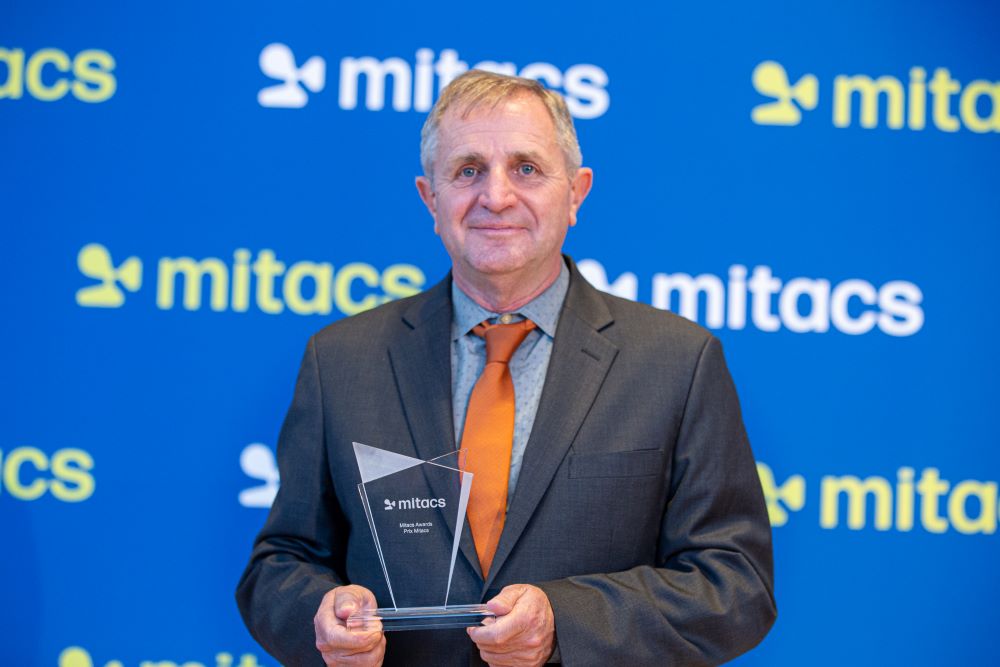Mitacs taps Prof. Bern Klein for exceptional leadership award


This year’s winner of the Mitacs Award for Exceptional Leadership – is Professor Dr. Bern Klein at the Norman B. Keevil Institute of Mining Engineering at the University of British Columbia. The Mitacs award recognizes an academic supervisor with an exemplary record of developing collaborations with industry and community, providing valuable research and training to their interns, and initiating research projects with significant outcomes through their Mitacs funding.
CMJ caught up with Prof. Klein at the International Mining Congress and Exhibition in Istanbul, Türkiey, where he was delivering a paper.
He said he had no idea that he had been nominated for the award. “I was touched and surprised,” he said. “And I have to give thanks to my interns and ex-students.”
Klein has accomplished groundbreaking work that will take mining to a greener future. He is a pioneer in sensor based bulk ore sorting that led the successful adaptation of X-ray fluorescence (XRF) on excavator buckets that allows operators to see the grade of the face as they dig. He has successfully promoted the use of high-pressure grinding rolls (HPGR) in place of SAG and ball grinding mills. And he is exploring the use of carbon dioxide (CO2) injection to break rocks.
Klein earned a BSC and PhD in mineral processing at the University of British Columbia, worked as a consultant, and then began teaching at UBC in January 2001. His knowledge and enthusiasm are contagious, even during a Zoom meeting.
Mine only ore
The use of sensor-based sorting to give real-time grade control was first tested by Inco, then Falconbridge, in Sudbury. For the XRF sorting on shovels, there sensors are mounted on the bucket, giving a continuous readout in the cabin. The operator can thus remove only the ore of the appropriate grade. This is a much more precise method than relying on block models. The XRF technology increases selectivity and lowers production costs because less waste is sent to the mill.
Using XRF sensors has been particularly advantageous in open pit copper mines. Where the average grade of copper in British Columbia mines is low, for example 0.3%. With the real-time information provided by the sensors the grade can be determined within +/– 0.03% % copper to classify as either ore or waste.
Klein has not stopped there. He is working with the UBC physics department on a sensor that will use laser ablation spectroscopy. LA-DCS technology is superior to LIBS and XRF in that it can be designed to provide data on many different minerals, including rare earth elements and lithium.
The high cost of comminution
The use of HPGR, which is beginning to be seen more often in mills, is another energy saver that Klein has championed. By industry estimates, 4% of the electric power generated in the province is used in grinding circuits in mineral processing plants. On average that HPGR circuits use on average 20% less energy than SAG circuits. Also, the throughput of a semi-autogenous grinding (SAG) mill varies depending on the hardness of the ore, an HPGR is much less sensitive, leading to energy savings.
Klein and his teams have developed a low-cost, bench scale test that can be used in the laboratory. The cost savings come with the reduced size; it can test samples of only a few kilograms as compared to several tonnes required for conventional pilot scale testing. As part of the Natural Resources Canada CrushIt! Challenge, it was shown that based HPGR circuits can replace both the SAG and ball mills with up to a 50% cut in energy use.
Surprising use for CO2
Klein and the technology developer are working on using CO2 to break rocks. The physics of rock breaking is such that rocks break more easily with the application of tension than with compression. The gas is subjected at high temperature and pressure until in a trans-critical phase. Then CO2 enters the rock pores and microfractures. With a sudden pressure drop, the CO2 expands to break the rock under tension. Observations showed that a portion of the CO2 chemically creates with the rock to form inert carbonate minerals at the same time. The energy saving can be 30%, he says, compared to conventional rock breaking.
The team mindset
Klein has mentored over 70 masters and PhD students via Mitacs and is quick to praise them.
“The real benefit of the Mitacs program is the straightforward and streamlined process they’ve developed to quickly pull together the industry projects, talented students and funding required to advance innovation in Canada,” said Klein.
“As researchers, there’s only so much we can do in our lab. To advance our ideas, we rely on industry partners to provide guidance, information and data that would be difficult to obtain otherwise,” he added.
Congratulations, Prof. Klein. Here’s to all your Mitacs students past, present, and future.
For more information about the Mitacs awards and a full list of winners, visit www.Mitacs.ca.
Comments